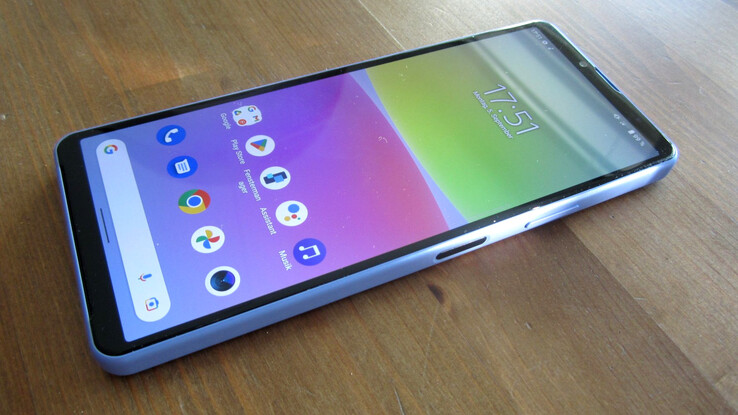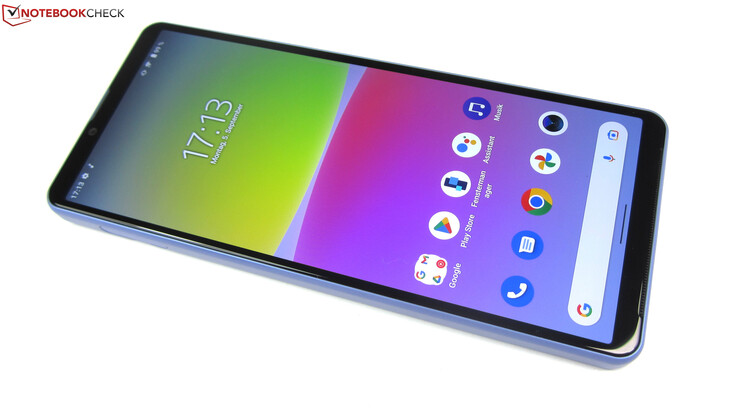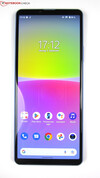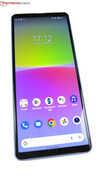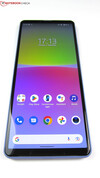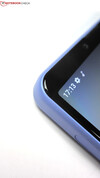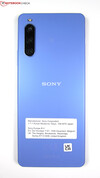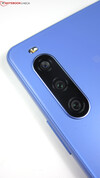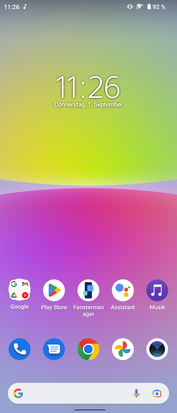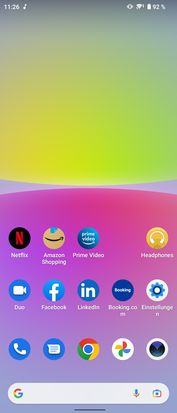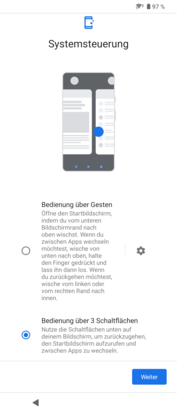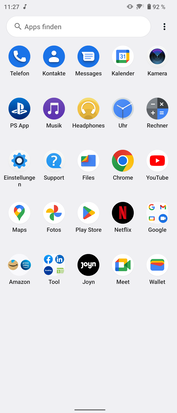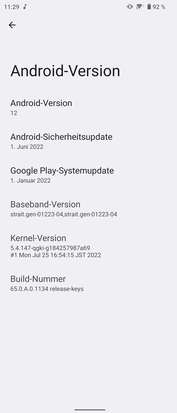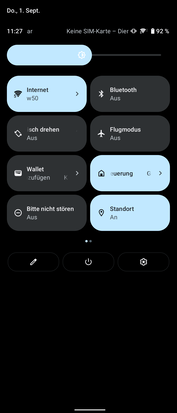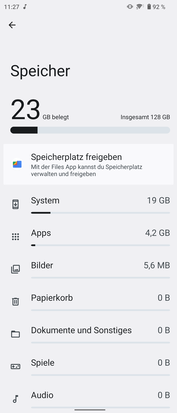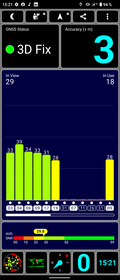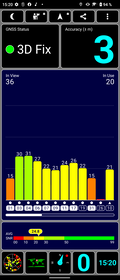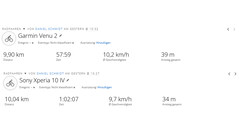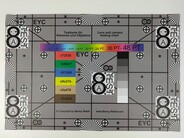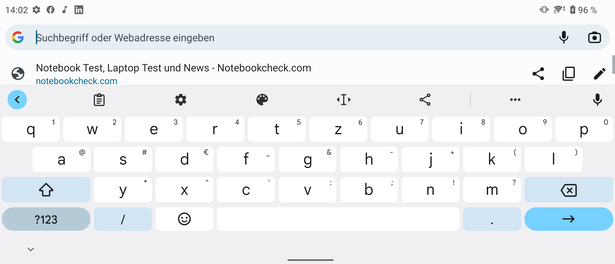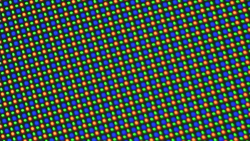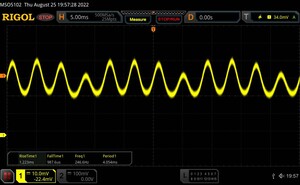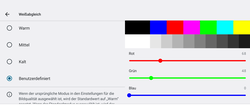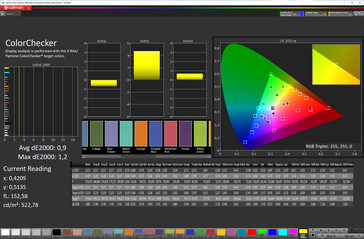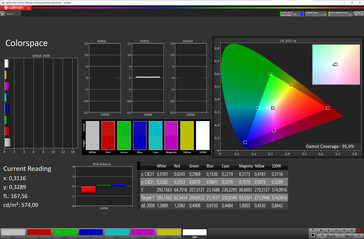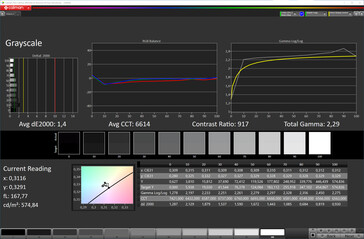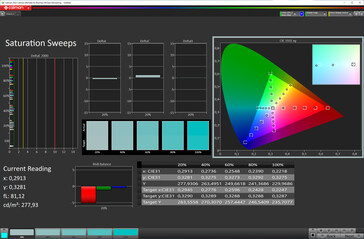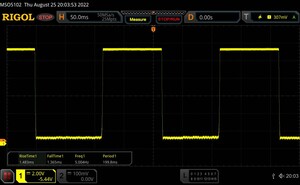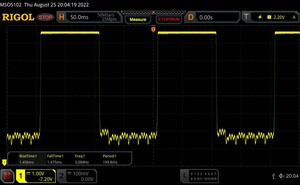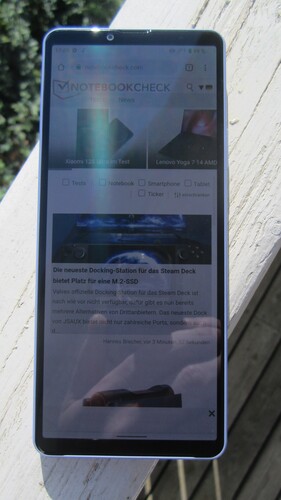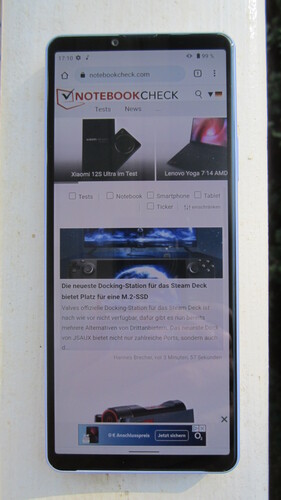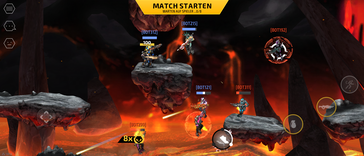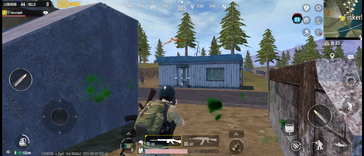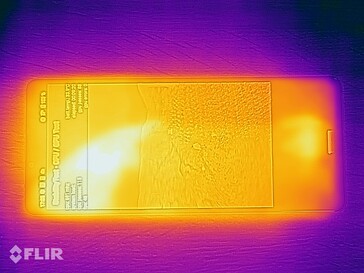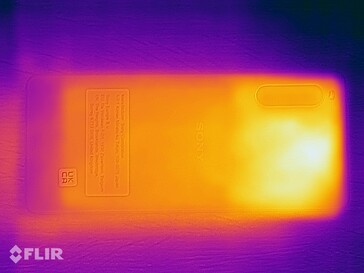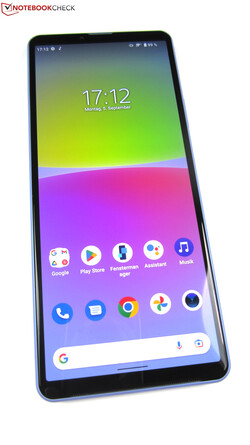Sony Xperia 10 IV smartphone review: Mini smartphone with outstanding battery life
Apple's first iPhone was launched in 2007 with a 3.5-inch display. By today's standards, it is downright tiny and would hardly find any takers, for buyers have now long been used to much larger displays. The standard form factor for smartphones is currently well over 6 inches and rising.
Nevertheless, many users swear by smartphones with a small form factor. They are light and compact, can be operated well with one hand, and still compete with the "big players" in terms of performance.
Sony's Xperia 10 IV falls exactly in this category. With its 6-inch AMOLED screen and mid-range Snapdragon 695 5G, it offers solid specs. Of particular interest is its immensely long battery runtimes, usually an Achilles' heel of small smartphones. Our review reveals how well the Xperia 10 IV fares against other compact smartphones.
Possible Competitors in Comparison
Rating | Date | Model | Weight | Drive | Size | Resolution | Price |
|---|---|---|---|---|---|---|---|
| 82.9 % v7 (old) | 09 / 2022 | Sony Xperia 10 IV SD 695 5G, Adreno 619 | 161 g | 128 GB UFS 2.1 Flash | 6.00" | 2520x1080 | |
| 86.1 % v7 (old) | 04 / 2022 | Apple iPhone SE 2022 A15, A15 GPU 5-Core | 144 g | 64 GB SSD | 4.70" | 1334x750 | |
| 85.9 % v7 (old) | 06 / 2021 | Asus ZenFone 8 SD 888 5G, Adreno 660 | 169 g | 256 GB UFS 3.1 Flash | 5.92" | 2400x1080 | |
| 89.3 % v7 (old) | 05 / 2022 | Samsung Galaxy S22 Exynos 2200, Xclipse 920 | 167 g | 128 GB UFS 3.1 Flash | 6.10" | 2340x1080 | |
| 83.4 % v7 (old) | 07 / 2021 | Sony Xperia 10 III SD 690 5G, Adreno 619L | 169 g | 128 GB UFS 2.1 Flash | 6.00" | 2520x1080 | |
| 87.7 % v7 (old) | 03 / 2022 | Xiaomi 12 SD 8 Gen 1, Adreno 730 | 179 g | 256 GB UFS 3.1 Flash | 6.28" | 2400x1080 |
Case - Very slim thanks to its 21:9 format
Sony is not following the crowd in regard to the design of its mid-range smartphone. The 6-inch phone uses relatively thick screen edges and, unlike some rivals in its price range, does without a curved display. Instead of a glass back, there is a matte plastic coating that also covers the bezel. It looks like a protective cover, feels high-quality and ensures good grip thanks to its light rubber coating. The smartphone comes in the colors lavender, mint, black and white.
An immediately striking design feature of the Xperia 10 IV is its unusual 21:9 screen format, which not only makes the phone look exceptionally slim - the Apple iPhone SE (2022) is barely wider - but it also feels very good in the hand. Due to its small form factor and low weight of 161 grams, the Sony feels like a significantly smaller smartphone overall.
Due to the slightly wider bezel on the top and bottom, the Xperia 10 IV does not need a display cutout for the selfie camera, so you can use the entire screen area. The selfie camera has been placed slightly to the left in the upper display frame and is hardly noticeable, even at second glance.
Despite the AMOLED panel, Sony has not placed the fingerprint sensor underneath the display, which is protected by Gorilla Glass Victus, but in the power button. The SIM/microSD slot can be opened without tools.
The Xperia 10 IV is IP65 and IP68 certified and thus both dust- and waterproof.
Equipment - Notification LED and eSIM support
Sony's Xperia 10 IV is available in only one configuration: 6 GB RAM and 128 GB UFS storage at around 450 Euros (~US$ 450) in Sony's store. The internal storage can be expanded via microSD card. There is also room for up to 2 nano-SIM cards in the card slot. eSIMs are also supported.
The Sony smartphone does not have an IR blaster nor radio reception. On the other hand, a 3.5 mm jack, USB-C 2.0 with OTG support, Bluetooth 5.1 and NFC are included. A notification LED is also available.
microSD Card Reader
The microSD card reader supports up to 1 TB storage media, which can also be formatted in the exFAT file system. The card reader achieves good sequential read and write rates with our Angelbird AV Pro V60 microSD reference card, but performs below average in the copy test.
| SD Card Reader - average JPG Copy Test (av. of 3 runs) | |
| Sony Xperia 10 III (Toshiba Exceria Pro M501) | |
| Sony Xperia 10 IV (Angelbird AV Pro V60) | |
Cross Platform Disk Test (CPDT)
Software - Android 12 with Xperia UI
Sony's Xperia 10 IV runs Android 12, on which the manufacturer has superimposed its own Xperia UI user interface. There are only a few changes compared to the stock Android, so that newcomers and those switching over can quickly find their way around. The few preinstalled third-party apps can all be uninstalled except for LinkedIn, which can only be deactivated.
Sony plans to provide the Xperia 10 IV with two years of Android upgrades and three years of security updates, with this timeframe being from the market launch (mid-June 2022). At the time of review in early September, the Android security patches were June 1 and therefore no longer quite up to date.
Communication and GNSS - Fast WiFi 5 and single-band GNSS
The Xperia 10 IV supports all current mobile standards including 5G. The frequency coverage is not broad, but solid and includes all important bands for the EU region.
In local networks, the Sony smartphone only communicates via WiFi 5, as neither WiFi 6 nor WiFi 6E are supported. Nevertheless, the Xperia 10 IV achieves above-average WiFi 5 transfer rates when connected to our Asus ROG Rapture GT-AXE11000 reference router, peaking at 715 MBit/s and thus clearly surpassing the WiFi data throughput of the predecessor. Moreover, data transfer is very stable in both the send and receive directions.
| Networking | |
| iperf3 receive AXE11000 | |
| Xiaomi 12 | |
| Samsung Galaxy S22 | |
| Apple iPhone SE 2022 | |
| Average of class Smartphone (52 - 1721, n=177, last 2 years) | |
| Sony Xperia 10 IV | |
| iperf3 transmit AXE11000 | |
| Apple iPhone SE 2022 | |
| Samsung Galaxy S22 | |
| Xiaomi 12 | |
| Sony Xperia 10 IV | |
| Average of class Smartphone (49.8 - 1828, n=177, last 2 years) | |
| iperf3 transmit AXE11000 6GHz | |
| Xiaomi 12 | |
| Average of class Smartphone (508 - 1945, n=94, last 2 years) | |
| iperf3 receive AXE11000 6GHz | |
| Xiaomi 12 | |
| Average of class Smartphone (451 - 1870, n=94, last 2 years) | |
| iperf3 transmit AX12 | |
| Asus ZenFone 8 | |
| Sony Xperia 10 III | |
| iperf3 receive AX12 | |
| Asus ZenFone 8 | |
| Sony Xperia 10 III | |
Localization of Sony's smartphone takes place via a number of GNSS systems, namely GPS (L1), Glonass (L1), Galileo (E1), Beidou (B1) and QZSS (L1). Under testing, it manages this quite quickly indoors and outdoors with an accuracy of up to 3 meters.
However, the Xperia 10 IV proves to be less accurate in matters of satellite positioning. On a 10-kilometer bike ride with the Garmin Venu2 fitness tracker for direct comparison, the smartphone's GNSS positioning often deviates from the actual route and makes one or two detours in more densely built-up urban areas. So you should be prepared for the eventuality that exact navigation with the Xperia 10 IV is not always possible in everyday use.
Telephony & Voice Quality
In addition to a microSD card, two nano-SIM cards also fit in the SIM slot of the Xperia 10 IV. VoLTE and Wi-Fi calls are supported. If two SIM cards are used, only one of them is able to access 5G. Alternatively, an eSIM can also be configured. With specific absorption rates of 0.99 W/kg (head SAR) and 1.22 W/kg (body SAR), the Sony does not belong to the category of low-radiation smartphones.
During phone calls, the Xperia 10 IV delivers good voice quality and blocks out background noise quite reliably. The caller sounds a little muffled in hands-free mode, but otherwise there are no communication problems via the loudspeaker at either end of the line.
Cameras - Sluggish triple camera with optical image stabilization
The Xperia 10 IV uses a triple camera that is almost unchanged from its predecessor. It consists of a 12 MP wide-angle camera (f/1.8, 1/2.8", FOV 79°), an 8 MP ultra-wide-angle camera (f/2.2, 1/4.0", FOV 120°) and an 8 MP telephoto camera with dual optical zoom (f/2.2, 1/4.4 FOV 43°). On the front is an 8 MP camera that takes good selfies.
In contrast to the predecessor, the optical image stabilizer also ensures blur-free recordings in videos. The videos are characterized by good image quality, but still only have a maximum resolution of 1080p at 60 FPS.
The photo app is not the fastest. If you move the smartphone quickly back and forth during video recordings, a lag effect occurs in which the display visibly lags behind the targeted subject. The camera app also reacts quite sluggishly when taking photos, especially in low-light conditions. Here it can take two seconds until the photo is taken.
In daylight, the smartphone takes decent photos with realistic-looking colors and also offers a lot of flexibility in subject selection thanks to its ultra-wide-angle camera and telephoto camera combination. However, the photos are only average in terms of detail and image sharpness, and simply bad at night.
Image comparison
Choose a scene and navigate within the first image. One click changes the position on touchscreens. One click on the zoomed-in image opens the original in a new window. The first image shows the scaled photograph of the test device.
Daylight shot 1Daylight shot 2Ultra wide angle5x zoomLow light shotIn the test lab, the main camera reproduces colors quite accurately with a maximum Delta-E of 9.51 under ideal lighting conditions. The test chart is also reproduced sharply. However, the color accuracy is over in 1 lux residual light and only the outlines of the test chart can be recognized.
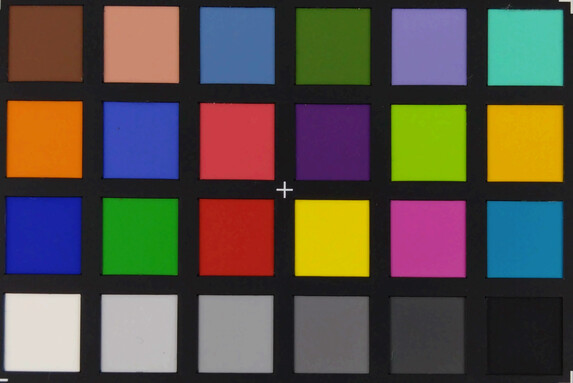

Accessories & Warranty - The 30-watt power adapter costs extra
Many smartphone manufacturers are choosing to forgo the power adapter in the scope of delivery. The Xperia 10 IV goes one step further, with the USB cable having also been omitted in the packaging, so the scope of delivery is limited to a quick guide and warranty information.
Sony offers two accessories specifically tailored to the Xperia 10 IV in its web store: a 30-watt fast charger (XQZ-UC1, around US$ 50) and a style cover with an integrated stand (XQZ-CBCC, around US$ 35).
The Sony Xperia 10 IV comes with a 24-month warranty in Germany. This may differ in other countries, so be sure to check with your supplier before buying.
Input Devices & Operation - Pleasant haptics and scalable display
The touchscreen of the Xperia 10 IV works with a sampling rate of 120 Hz and implements inputs without any noticeable delay. The Snapdragon 695 5G enables largely smooth operation. The eight-core SoC offers enough performance for everyday tasks as long as multitasking is not the focus.
Icons, menus and fonts appear quite small due to the high display resolution of 2560x1080. If necessary, the display size of the screen elements can be adjusted in 5 levels in the Android settings. The preset is level 2, leaving plenty of room for enlargement. Due to the elongated display, operation with one hand is not always easy, but this can be overcome with the switchable one-hand mode.
The physical keys sit firmly in the case, have a crisp pressure point and provide pleasant feedback. The power button is built deeply in the chassis and can thus be easily felt without looking. If you place your finger on the power button, the integrated fingerprint sensor unlocks the smartphone quickly and reliably and also works when the display is turned off.
The Xperia 10 IV does not offer face recognition.
Display - Crisp display with 60 Hz
The display of the Xperia 10 IV does not differ from its predecessor. On the one hand, this is good because the AMOLED panel displays content extremely sharply thanks to its high pixel density of 457 PPI. However, the frame rate of 60 Hz is no longer in keeping with the times. Most other devices in this price range now offer 90 or even 120 Hz.
In terms of brightness, the AMOLED display also barely differs from that of the Xperia 10 III. We measured an average of 580.1 cd/m² with the brightness sensor disabled. Up to 573 cd/m² is possible with the sensor enabled. If the brightness measurement is restricted to a smaller image area (APL18), the luminance increases up to 756 cd/m². At the lowest brightness level, the AMOLED panel still shines with 2.86 cd/m².
The display flickers in all brightness levels in a frequency range of 60 to 253 Hz. Owing to the fairly flat and even amplitude curve, the PWM flickering shouldn't be an issue, even for sensitive users.
| |||||||||||||||||||||||||
Brightness Distribution: 96 %
Center on Battery: 572 cd/m²
Contrast: ∞:1 (Black: 0 cd/m²)
ΔE ColorChecker Calman: 0.9 | ∀{0.5-29.43 Ø4.78}
ΔE Greyscale Calman: 1.4 | ∀{0.09-98 Ø5}
95.9% sRGB (Calman 2D)
Gamma: 2.29
CCT: 6614 K
| Sony Xperia 10 IV OLED, 2520x1080, 6" | Apple iPhone SE 2022 IPS, 1334x750, 4.7" | Asus ZenFone 8 AMOLED, 2400x1080, 5.9" | Samsung Galaxy S22 AMOLED, 2340x1080, 6.1" | Sony Xperia 10 III OLED, 2520x1080, 6" | Xiaomi 12 OLED, 2400x1080, 6.3" | |
|---|---|---|---|---|---|---|
| Screen | -59% | -47% | -36% | -14% | -47% | |
| Brightness middle (cd/m²) | 572 | 662 16% | 758 33% | 853 49% | 536 -6% | 867 52% |
| Brightness (cd/m²) | 580 | 647 12% | 759 31% | 858 48% | 540 -7% | 867 49% |
| Brightness Distribution (%) | 96 | 92 -4% | 98 2% | 96 0% | 97 1% | 98 2% |
| Black Level * (cd/m²) | 0.4 | |||||
| Colorchecker dE 2000 * | 0.9 | 1.44 -60% | 3.5 -289% | 1.9 -111% | 1.1 -22% | 1.7 -89% |
| Colorchecker dE 2000 max. * | 1.2 | 4.74 -295% | 3.2 -167% | 1.9 -58% | 4.4 -267% | |
| Greyscale dE 2000 * | 1.4 | 1.7 -21% | 1.6 -14% | 1.9 -36% | 1.3 7% | 1.8 -29% |
| Gamma | 2.29 96% | 2.179 101% | 2.23 99% | 2.07 106% | 2.27 97% | 2.2 100% |
| CCT | 6614 98% | 6746 96% | 6527 100% | 6460 101% | 6494 100% | 6762 96% |
| Contrast (:1) | 1655 |
* ... smaller is better
Screen Flickering / PWM (Pulse-Width Modulation)
| Screen flickering / PWM detected | 253 Hz | ||
The display backlight flickers at 253 Hz (worst case, e.g., utilizing PWM) . The frequency of 253 Hz is relatively high, so most users sensitive to PWM should not notice any flickering. However, there are reports that some users are still sensitive to PWM at 500 Hz and above, so be aware. In comparison: 53 % of all tested devices do not use PWM to dim the display. If PWM was detected, an average of 8108 (minimum: 5 - maximum: 343500) Hz was measured. | |||
Series of measurements at a fixed zoom level and different brightness settings
The display colors of the Xperia 10 IV can be adjusted via two image modes ("Original Mode" and "Standard Mode"). You can also adjust the white balance via the three profiles "Warm", "Medium" and "Cold" or manually by adjusting the RGB channels.
If you prefer the most natural color representation possible, then "Original Mode" is the best choice. At the same time we recommend manually adjusting the white balance and using the RGB settings shown in the screenshot. The Xperia 10 IV then falls within the ideal range in terms of color and grayscale reproduction.
Display Response Times
| ↔ Response Time Black to White | ||
|---|---|---|
| 2.85 ms ... rise ↗ and fall ↘ combined | ↗ 1.483 ms rise | |
| ↘ 1.365 ms fall | ||
| The screen shows very fast response rates in our tests and should be very well suited for fast-paced gaming. In comparison, all tested devices range from 0.1 (minimum) to 240 (maximum) ms. » 13 % of all devices are better. This means that the measured response time is better than the average of all tested devices (20.2 ms). | ||
| ↔ Response Time 50% Grey to 80% Grey | ||
| 2.93 ms ... rise ↗ and fall ↘ combined | ↗ 1.456 ms rise | |
| ↘ 1.475 ms fall | ||
| The screen shows very fast response rates in our tests and should be very well suited for fast-paced gaming. In comparison, all tested devices range from 0.165 (minimum) to 636 (maximum) ms. » 12 % of all devices are better. This means that the measured response time is better than the average of all tested devices (31.6 ms). | ||
Sony's smartphone performs relatively well outdoors. The AMOLED screen's luminance is not quite sufficient to display all contents legibly in direct sunlight. However, there are no problems in a shady spot. Thanks to the high viewing-angle stability, the display can be seen from all kinds of angles.
Performance - Solid performance, but barely faster than its predecessor
The Snapdragon 695 5G in the Xperia 10 IV is a slightly faster SoC than in the predecessor. Both the Snapdragon 695 5G and the Snapdragon 690 5G of the Xperia 10 III are in the lower mid-range, offer sufficient performance for everyday use and also run games smoothly. However, the SoC is not designed for particularly computationally intensive tasks, such as video editing or multitasking with multiple applications open at the same time.
In the synthetic benchmarks, the Xperia 10 IV and its Snapdragon 695 5G only manage a place in the lower range of the test field. With the exception of the Xperia 10 III, all compact comparison devices are considerably faster. In terms of performance, the Xperia 10 IV hardly stands out from its predecessor.
| CrossMark - Overall | |
| Average of class Smartphone (187 - 2674, n=123, last 2 years) | |
| Apple iPhone SE 2022 | |
| Xiaomi 12 | |
| Samsung Galaxy S22 | |
| Average Qualcomm Snapdragon 695 5G (521 - 606, n=18) | |
| Sony Xperia 10 IV | |
| AImark - Score v2.x | |
| Apple iPhone SE 2022 | |
| Sony Xperia 10 III | |
| Xiaomi 12 | |
| Samsung Galaxy S22 | |
| Average Qualcomm Snapdragon 695 5G (4924 - 5839, n=10) | |
| Sony Xperia 10 IV | |
The GPU benchmarks also produce the same results as in the synthetic benchmarks. The Xperia 10 IV is slightly faster than the Xperia 10 III (Adreno 619L) with its Adreno 619 graphics chip, but cannot compete with the other mid-range rivals. But jerks or other stutters occur only rarely during operation.
| GFXBench | |
| on screen Aztec Ruins High Tier Onscreen | |
| Xiaomi 12 | |
| Apple iPhone SE 2022 | |
| Samsung Galaxy S22 | |
| Asus ZenFone 8 | |
| Sony Xperia 10 IV | |
| Sony Xperia 10 III | |
| 2560x1440 Aztec Ruins High Tier Offscreen | |
| Xiaomi 12 | |
| Apple iPhone SE 2022 | |
| Samsung Galaxy S22 | |
| Asus ZenFone 8 | |
| Sony Xperia 10 IV | |
| Sony Xperia 10 III | |
| on screen Aztec Ruins Normal Tier Onscreen | |
| Xiaomi 12 | |
| Samsung Galaxy S22 | |
| Apple iPhone SE 2022 | |
| Asus ZenFone 8 | |
| Sony Xperia 10 IV | |
| Sony Xperia 10 III | |
| 1920x1080 Aztec Ruins Normal Tier Offscreen | |
| Xiaomi 12 | |
| Apple iPhone SE 2022 | |
| Samsung Galaxy S22 | |
| Asus ZenFone 8 | |
| Sony Xperia 10 IV | |
| Sony Xperia 10 III | |
| on screen Car Chase Onscreen | |
| Xiaomi 12 | |
| Samsung Galaxy S22 | |
| Apple iPhone SE 2022 | |
| Asus ZenFone 8 | |
| Sony Xperia 10 IV | |
| Sony Xperia 10 III | |
| 1920x1080 Car Chase Offscreen | |
| Apple iPhone SE 2022 | |
| Xiaomi 12 | |
| Samsung Galaxy S22 | |
| Asus ZenFone 8 | |
| Sony Xperia 10 IV | |
| Sony Xperia 10 III | |
| GFXBench 3.1 | |
| on screen Manhattan ES 3.1 Onscreen | |
| Xiaomi 12 | |
| Samsung Galaxy S22 | |
| Asus ZenFone 8 | |
| Apple iPhone SE 2022 | |
| Sony Xperia 10 IV | |
| Sony Xperia 10 III | |
| 1920x1080 Manhattan ES 3.1 Offscreen | |
| Xiaomi 12 | |
| Samsung Galaxy S22 | |
| Asus ZenFone 8 | |
| Apple iPhone SE 2022 | |
| Sony Xperia 10 IV | |
| Sony Xperia 10 III | |
| GFXBench 3.0 | |
| on screen Manhattan Onscreen OGL | |
| Xiaomi 12 | |
| Samsung Galaxy S22 | |
| Asus ZenFone 8 | |
| Apple iPhone SE 2022 | |
| Sony Xperia 10 IV | |
| Sony Xperia 10 III | |
| 1920x1080 1080p Manhattan Offscreen | |
| Xiaomi 12 | |
| Samsung Galaxy S22 | |
| Apple iPhone SE 2022 | |
| Asus ZenFone 8 | |
| Sony Xperia 10 IV | |
| Sony Xperia 10 III | |
| GFXBench (DX / GLBenchmark) 2.7 | |
| T-Rex Onscreen | |
| Xiaomi 12 | |
| Asus ZenFone 8 | |
| Samsung Galaxy S22 | |
| Apple iPhone SE 2022 | |
| Sony Xperia 10 IV | |
| Sony Xperia 10 III | |
| 1920x1080 T-Rex Offscreen | |
| Xiaomi 12 | |
| Apple iPhone SE 2022 | |
| Samsung Galaxy S22 | |
| Asus ZenFone 8 | |
| Sony Xperia 10 IV | |
| Sony Xperia 10 III | |
The Sony smartphone is also slower than the competition in the browser benchmarks and can only beat the Xperia 10 III. Nevertheless, websites load quickly and can be scrolled through swiftly.
| Jetstream 2 - 2.0 Total Score | |
| Apple iPhone SE 2022 (Chrome 99) | |
| Average of class Smartphone (23.8 - 387, n=149, last 2 years) | |
| Xiaomi 12 (Chrome 99.0.4844.58) | |
| Samsung Galaxy S22 (Chrome 100.0.4896.79) | |
| Average Qualcomm Snapdragon 695 5G (48.6 - 105.3, n=19) | |
| Sony Xperia 10 IV (Chrome 103.0.5060.129) | |
| Sony Xperia 10 III (Chrome 91) | |
| Speedometer 2.0 - Result 2.0 | |
| Apple iPhone SE 2022 (Chome 99) | |
| Average of class Smartphone (15.2 - 643, n=122, last 2 years) | |
| Samsung Galaxy S22 (Chrome 100.0.4896.79) | |
| Xiaomi 12 (Chrome 99.0.4844.58) | |
| Average Qualcomm Snapdragon 695 5G (38.7 - 80.1, n=16) | |
| Sony Xperia 10 IV (Chrome 103.0.5060.129) | |
| Sony Xperia 10 III (Chrome 91) | |
| WebXPRT 3 - Overall | |
| Apple iPhone SE 2022 (Chrome 99) | |
| Average of class Smartphone (38 - 380, n=31, last 2 years) | |
| Asus ZenFone 8 (Chrome 90) | |
| Samsung Galaxy S22 (Chrome 100.0.4896.79) | |
| Xiaomi 12 (Chrome 99.0.4844.58) | |
| Average Qualcomm Snapdragon 695 5G (75 - 156, n=12) | |
| Sony Xperia 10 IV (Chrome 103.0.5060.129) | |
| Sony Xperia 10 III (Chrome 91) | |
| Octane V2 - Total Score | |
| Apple iPhone SE 2022 (Chrome 99) | |
| Average of class Smartphone (2228 - 121337, n=197, last 2 years) | |
| Samsung Galaxy S22 (Chrome 100.0.4896.79) | |
| Asus ZenFone 8 (Chrome 90) | |
| Xiaomi 12 (Chrome 99.0.4844.58) | |
| Average Qualcomm Snapdragon 695 5G (17849 - 31647, n=21) | |
| Sony Xperia 10 IV (Chrome 103.0.5060.129) | |
| Sony Xperia 10 III | |
| Mozilla Kraken 1.1 - Total | |
| Sony Xperia 10 III (Chrome 91) | |
| Sony Xperia 10 IV (Chrome 103.0.5060.129) | |
| Average Qualcomm Snapdragon 695 5G (1298 - 2501, n=18) | |
| Samsung Galaxy S22 (Chrome 100.0.4896.79) | |
| Asus ZenFone 8 (Chrome 90) | |
| Average of class Smartphone (257 - 28190, n=154, last 2 years) | |
| Xiaomi 12 (Chrome 99.0.4844.58) | |
| Apple iPhone SE 2022 (Chrome 99) | |
* ... smaller is better
With its UFS 2.1 storage, the Xperia 10 IV achieves solid data transfer rates. However, it is slower than the Xperia 10 III in sequential reading, which is noticeable from the slightly longer app loading times.
| Sony Xperia 10 IV | Asus ZenFone 8 | Samsung Galaxy S22 | Sony Xperia 10 III | Xiaomi 12 | Average 128 GB UFS 2.1 Flash | Average of class Smartphone | |
|---|---|---|---|---|---|---|---|
| AndroBench 3-5 | 100% | 93% | 13% | 164% | -11% | 186% | |
| Sequential Read 256KB (MB/s) | 521.1 | 1781 242% | 1486 185% | 840 61% | 1851 255% | 761 ? 46% | 2228 ? 328% |
| Sequential Write 256KB (MB/s) | 497.61 | 767 54% | 993 100% | 400.8 -19% | 1417 185% | 296 ? -41% | 1852 ? 272% |
| Random Read 4KB (MB/s) | 192.5 | 292.3 52% | 273 42% | 172.3 -10% | 325.2 69% | 154 ? -20% | 296 ? 54% |
| Random Write 4KB (MB/s) | 177.83 | 272.9 53% | 257.6 45% | 210.7 18% | 437.5 146% | 130.4 ? -27% | 339 ? 91% |
Gaming - OK for casual gamers
The Adreno 619 graphics chip integrated into the Snapdragon 695 5G belongs to the lower mid-range in terms of performance, just like the SoC. Even so, its power is sufficient to run current games without major restrictions. For example, PUBG Mobile can be played smoothly in "HD/High" at a constant 30 FPS. Even higher frame rates than 60 FPS would be possible in the graphically simpler Armajet, but the 60 Hz panel does not allow more.
Frame rates were determined with our Gamebench test tool.
Emissions - Mono speakers and high-resolution audio
Temperature
In terms of temperature, the Xperia 10 IV is pleasant to use at all times because the smartphone only heats up to a maximum of 33.4 °C, even under permanent load. Internally, everything stays cool. As the 3D-Mark stress tests show, there are practically no performance losses from the first to the last test run.
(+) The maximum temperature on the upper side is 31.4 °C / 89 F, compared to the average of 35.2 °C / 95 F, ranging from 21.9 to 247 °C for the class Smartphone.
(+) The bottom heats up to a maximum of 33.4 °C / 92 F, compared to the average of 34 °C / 93 F
(+) In idle usage, the average temperature for the upper side is 27.6 °C / 82 F, compared to the device average of 32.9 °C / 91 F.
3DMark Wild Life Stress Test
| 3DMark | |
| Wild Life Stress Test Stability | |
| Sony Xperia 10 IV | |
| Sony Xperia 10 III | |
| Asus ZenFone 8 | |
| Apple iPhone SE 2022 | |
| Samsung Galaxy S22 | |
| Xiaomi 12 | |
| Wild Life Extreme Stress Test | |
| Sony Xperia 10 III | |
| Sony Xperia 10 IV | |
| Asus ZenFone 8 | |
| Apple iPhone SE 2022 | |
| Samsung Galaxy S22 | |
| Xiaomi 12 | |
Speakers
The mono speaker of the Xperia 10 IV is located in a small recess on the bottom side of the display. The small sound membrane does its job well, but produces only a thin sound with no bass. In return, the speaker transmits mids and highs that are very well-balanced, thus reproducing voices very clearly.
Headsets and other external audio devices can be connected to the Sony smartphone via the 3.5 mm jack or Bluetooth 5.1. Common Bluetooth codecs such as AAC, LDAC and aptX Adaptive are supported.
With compatible headphones, you can also enjoy high-resolution audio with both wired and wireless connections. However, the signal-to-noise ratio of the 3.5 mm audio jack, which is only average at 75.71 dBFS, does not fit well here.
Sony Xperia 10 IV audio analysis
(+) | speakers can play relatively loud (85.8 dB)
Bass 100 - 315 Hz
(-) | nearly no bass - on average 25.5% lower than median
(±) | linearity of bass is average (10.4% delta to prev. frequency)
Mids 400 - 2000 Hz
(±) | higher mids - on average 5.9% higher than median
(+) | mids are linear (6.4% delta to prev. frequency)
Highs 2 - 16 kHz
(+) | balanced highs - only 4.6% away from median
(+) | highs are linear (6.2% delta to prev. frequency)
Overall 100 - 16.000 Hz
(±) | linearity of overall sound is average (20.6% difference to median)
Compared to same class
» 35% of all tested devices in this class were better, 9% similar, 56% worse
» The best had a delta of 11%, average was 35%, worst was 134%
Compared to all devices tested
» 54% of all tested devices were better, 8% similar, 38% worse
» The best had a delta of 4%, average was 24%, worst was 134%
Sony Xperia 10 III audio analysis
(+) | speakers can play relatively loud (88.7 dB)
Bass 100 - 315 Hz
(-) | nearly no bass - on average 35.2% lower than median
(±) | linearity of bass is average (7.4% delta to prev. frequency)
Mids 400 - 2000 Hz
(±) | reduced mids - on average 6% lower than median
(+) | mids are linear (5.2% delta to prev. frequency)
Highs 2 - 16 kHz
(+) | balanced highs - only 3.6% away from median
(+) | highs are linear (5.6% delta to prev. frequency)
Overall 100 - 16.000 Hz
(±) | linearity of overall sound is average (21.7% difference to median)
Compared to same class
» 43% of all tested devices in this class were better, 8% similar, 49% worse
» The best had a delta of 11%, average was 35%, worst was 134%
Compared to all devices tested
» 61% of all tested devices were better, 7% similar, 32% worse
» The best had a delta of 4%, average was 24%, worst was 134%
Battery life - Hard gets any smaller, but long charging times
Power Consumption
Sony does not include a power adapter with its smartphone. Users either have to make do with the optional 30-watt XQZ-UC1 quick charger or any other power adapter within reach. Since Sony charges almost US$ 50 for the power adapter, the second option sounds more appealing. However, unlike us, you need a little luck in ensuring that you have the right power adapter.
The Sony Xperia 10 IV supports USB Power Delivery (PD) with a maximum of 30 watts. The official power adapter is tailored to match this perfectly. This charging capacity can also be achieved with a third-party power supply, but is not guaranteed.
The Sony smartphone did not like our third-party power adapters so much, presumably because of the deviating amperages from the original power supply. Example: Connected to a 24-watt power supply from Anker, the smartphone only extracted a maximum of 7.5 watts, which meant that a full charge took over 3.5 hours. Of course, this result is not representative, but shows that it can be difficult to find the right power adapter if you want to save money on the Sony power adapter.
In terms of power consumption, the Sony Xperia 10 IV is inconspicuous.
| Off / Standby | |
| Idle | |
| Load |
|
Key:
min: | |
| Sony Xperia 10 IV 5000 mAh | Apple iPhone SE 2022 2018 mAh | Asus ZenFone 8 4000 mAh | Samsung Galaxy S22 3700 mAh | Sony Xperia 10 III 4500 mAh | Xiaomi 12 4500 mAh | Average Qualcomm Snapdragon 695 5G | Average of class Smartphone | |
|---|---|---|---|---|---|---|---|---|
| Power Consumption | -45% | -14% | -42% | 24% | -36% | -23% | -65% | |
| Idle Minimum * (Watt) | 0.68 | 0.6 12% | 0.82 -21% | 0.69 -1% | 0.44 35% | 0.87 -28% | 0.886 ? -30% | 0.842 ? -24% |
| Idle Average * (Watt) | 1.69 | 0.9 47% | 1.1 35% | 1.19 30% | 0.65 62% | 1.7 -1% | 1.76 ? -4% | 1.439 ? 15% |
| Idle Maximum * (Watt) | 1.73 | 1.5 13% | 1.16 33% | 1.26 27% | 0.69 60% | 1.82 -5% | 1.92 ? -11% | 1.624 ? 6% |
| Load Average * (Watt) | 2.54 | 6.5 -156% | 4.24 -67% | 6.97 -174% | 2.99 -18% | 4.68 -84% | 3.86 ? -52% | 7.03 ? -177% |
| Load Maximum * (Watt) | 4.61 | 11 -139% | 6.83 -48% | 8.85 -92% | 5.42 -18% | 7.41 -61% | 5.45 ? -18% | 11.3 ? -145% |
* ... smaller is better
Power Consumption: Geekbench (150 cd/m²)
Power Consumption: GFXBench (150 cd/m²)
Battery Life
Compact smartphones often only have a small battery, which means that runtimes are usually unimpressive. This usually applies to devices from the Android range. In Apple smartphones, all system components are more finely tuned, which is why even small devices like the iPhone SE (2022) have very competitive runtimes. At 2018 mAh, the iPhone SE (2022) has a very small battery by Android standards.
The Sony Xperia 10 IV stands out from the competition in terms of battery life in two positive ways. Firstly, because it has a very large battery (5000 mAh) for its compact format. And secondly, because one battery charge helps it achieve excellent runtimes that no other comparison device can match.
Under testing, simulated web surfing lasted over 19 hours, and continuous video playback even lasted 26 hours. Even under maximum load, the battery puts on a strong show, lasting just over 7 hours. In practice, one should reasonably expect the smartphone to last two days before charging is necessary, even under intensive use.
| Sony Xperia 10 IV 5000 mAh | Apple iPhone SE 2022 2018 mAh | Asus ZenFone 8 4000 mAh | Samsung Galaxy S22 3700 mAh | Sony Xperia 10 III 4500 mAh | Xiaomi 12 4500 mAh | |
|---|---|---|---|---|---|---|
| Battery runtime | -48% | -62% | -38% | -18% | -31% | |
| Reader / Idle (h) | 62.7 | 34.2 -45% | 36.4 -42% | 37.9 -40% | 42.6 -32% | |
| H.264 (h) | 26.3 | 13.3 -49% | 14.8 -44% | 23.5 -11% | 14.8 -44% | |
| WiFi v1.3 (h) | 19.5 | 12.8 -34% | 7.4 -62% | 11.3 -42% | 13.5 -31% | 12.7 -35% |
| Load (h) | 7.2 | 2.7 -62% | 5.4 -25% | 8 11% | 6.4 -11% |
Pros
Cons
Verdict on the Sony Xperia 10 IV
Sony's Xperia 10 IV is a good mid-range smartphone with strong hardware and enough performance for everyday use. In addition to an AMOLED display with very good image quality, there is 5G, real dual-SIM, and the option of expanding the memory through a microSD card. A 3.5 mm audio jack and IP certification are also included.
The Xperia 10 IV stands out from the competition mainly because of its form factor and battery life. Its 21:9 format makes the smartphone particularly slim, making it feel like an even smaller device. Moreover, the widescreen format and the selfie camera integrated into the frame ensure that movies are displayed without black areas.
Sony's Xperia 10 IV is a very slim mid-range smartphone with strong features and excellent battery runtimes, but stumbles in terms of display and camera.
Small smartphones are often accompanied by unimpressive battery runtimes. The Xperia 10 IV is the opposite, extracting excellent battery runtimes out of its 5000 mAh battery, which hardly any other compact smartphone can match.
Our overall positive impression falters only in a few places. The AMOLED screen only works with a refresh rate of 60 Hz, which is hardly appropriate for this price range. The triple camera also leaves an mixed impression. It takes decent pictures in daylight, but the shutter delays are quite long and night pictures are hardly usable. The SoC could have been faster as well because you notice that the smartphone occasionally reaches its performance limits during use.
Alternatives to Sony's Xperia 10 IV are, for example, the Xiaomi 12 and the Asus ZenFone 8. Both are much faster at similar prices and offer an AMOLED display with 120 Hz.
Price and Availability
The Sony Xperia 10 IV is available in the US via Amazon for $429.99, and in the UK for £370.00. France and Italy offer the smartphone for 449,96€ and 495,00€, respectively. Amazon India also offers the smartphone in two colors for ₹42,999.00.
Sony Xperia 10 IV
- 09/12/2022 v7 (old)
Manuel Masiero




